Stroop Effect: Psychology Report on Cognitive Interference
VerifiedAdded on 2023/01/11
|17
|4746
|22
Report
AI Summary
This report provides an in-depth analysis of the Stroop Effect, a cognitive phenomenon where the interference in the reaction time of a task occurs. The study explores the background, method, and discussion of the Stroop effect, including the experiments conducted by John Ridley Stroop in 1935. It examines the concepts of cognitive interference, selective attention, and the speed of processing theory. The report also explores the impact of social priming and dyslexia on the Stroop effect, comparing congruent and incongruent trials. It discusses various factors that can reduce the Stroop effect, such as suggestion and meditation. The report covers the daily routine of a 25-year-old with dyslexia and discusses the implications of the Stroop effect in clinical and mental applications. The report references studies by Bargh, Raz, and others, providing a comprehensive overview of the Stroop effect and its applications.
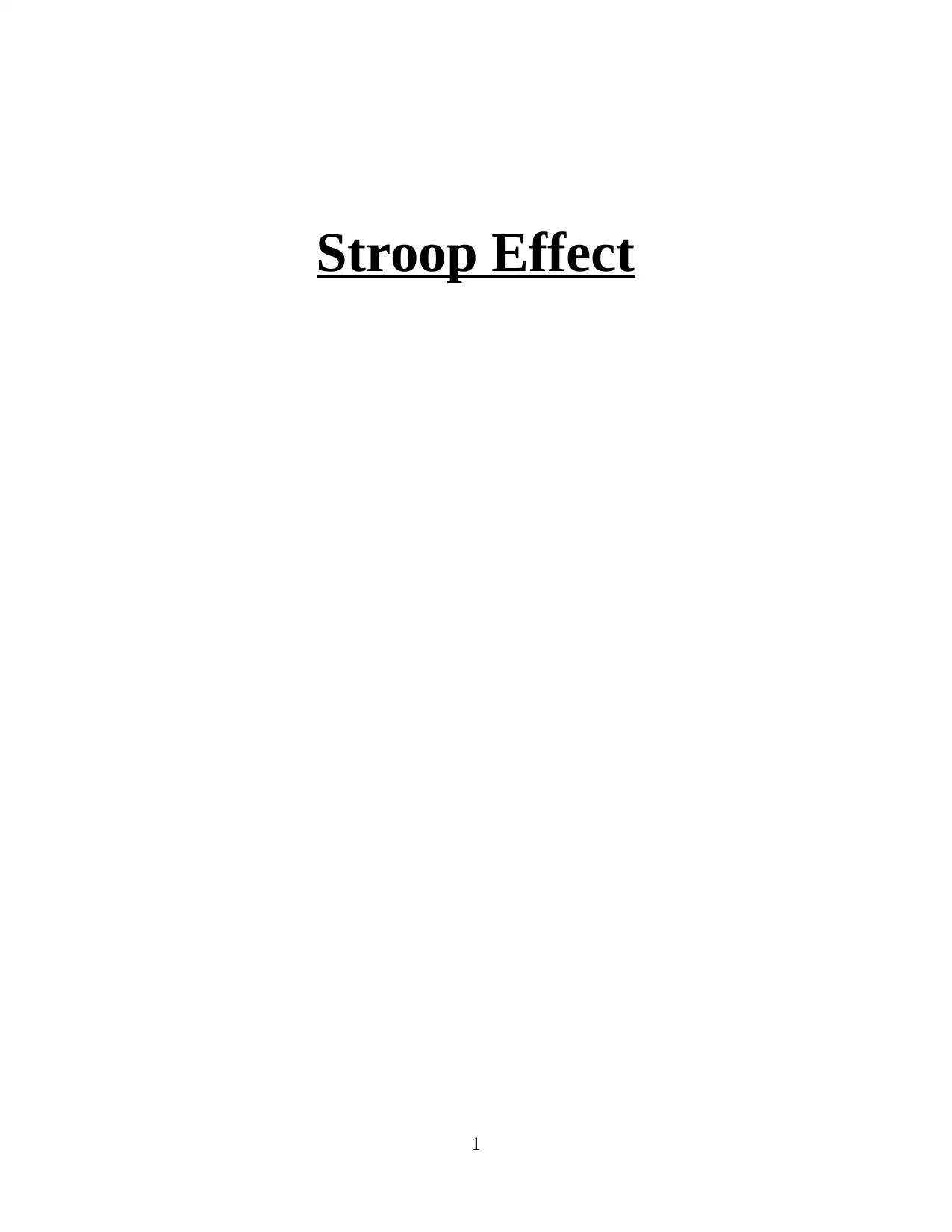
Stroop Effect
1
1
Paraphrase This Document
Need a fresh take? Get an instant paraphrase of this document with our AI Paraphraser

2
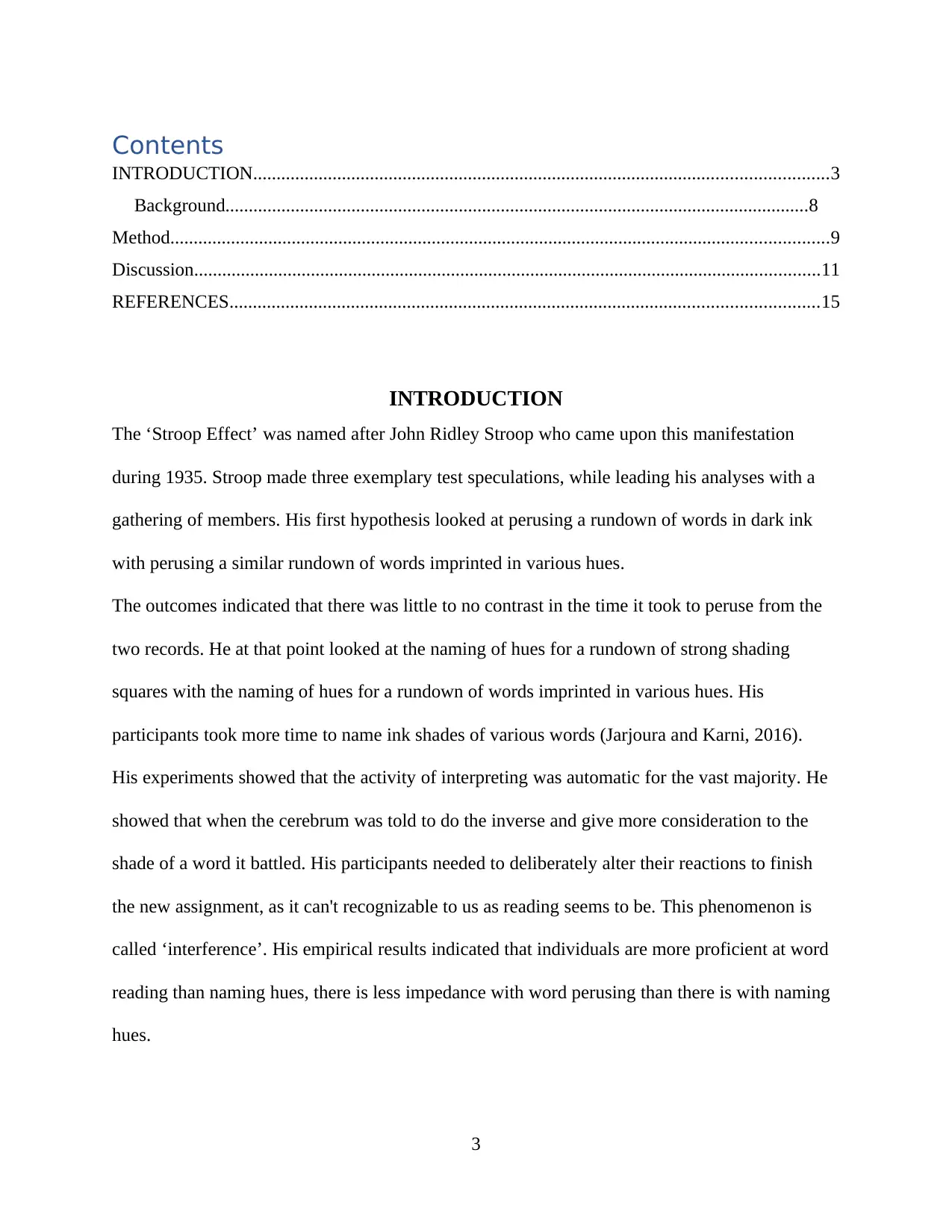
Contents
INTRODUCTION...........................................................................................................................3
Background.............................................................................................................................8
Method.............................................................................................................................................9
Discussion......................................................................................................................................11
REFERENCES..............................................................................................................................15
INTRODUCTION
The ‘Stroop Effect’ was named after John Ridley Stroop who came upon this manifestation
during 1935. Stroop made three exemplary test speculations, while leading his analyses with a
gathering of members. His first hypothesis looked at perusing a rundown of words in dark ink
with perusing a similar rundown of words imprinted in various hues.
The outcomes indicated that there was little to no contrast in the time it took to peruse from the
two records. He at that point looked at the naming of hues for a rundown of strong shading
squares with the naming of hues for a rundown of words imprinted in various hues. His
participants took more time to name ink shades of various words (Jarjoura and Karni, 2016).
His experiments showed that the activity of interpreting was automatic for the vast majority. He
showed that when the cerebrum was told to do the inverse and give more consideration to the
shade of a word it battled. His participants needed to deliberately alter their reactions to finish
the new assignment, as it can't recognizable to us as reading seems to be. This phenomenon is
called ‘interference’. His empirical results indicated that individuals are more proficient at word
reading than naming hues, there is less impedance with word perusing than there is with naming
hues.
3
INTRODUCTION...........................................................................................................................3
Background.............................................................................................................................8
Method.............................................................................................................................................9
Discussion......................................................................................................................................11
REFERENCES..............................................................................................................................15
INTRODUCTION
The ‘Stroop Effect’ was named after John Ridley Stroop who came upon this manifestation
during 1935. Stroop made three exemplary test speculations, while leading his analyses with a
gathering of members. His first hypothesis looked at perusing a rundown of words in dark ink
with perusing a similar rundown of words imprinted in various hues.
The outcomes indicated that there was little to no contrast in the time it took to peruse from the
two records. He at that point looked at the naming of hues for a rundown of strong shading
squares with the naming of hues for a rundown of words imprinted in various hues. His
participants took more time to name ink shades of various words (Jarjoura and Karni, 2016).
His experiments showed that the activity of interpreting was automatic for the vast majority. He
showed that when the cerebrum was told to do the inverse and give more consideration to the
shade of a word it battled. His participants needed to deliberately alter their reactions to finish
the new assignment, as it can't recognizable to us as reading seems to be. This phenomenon is
called ‘interference’. His empirical results indicated that individuals are more proficient at word
reading than naming hues, there is less impedance with word perusing than there is with naming
hues.
3
⊘ This is a preview!⊘
Do you want full access?
Subscribe today to unlock all pages.

Trusted by 1+ million students worldwide
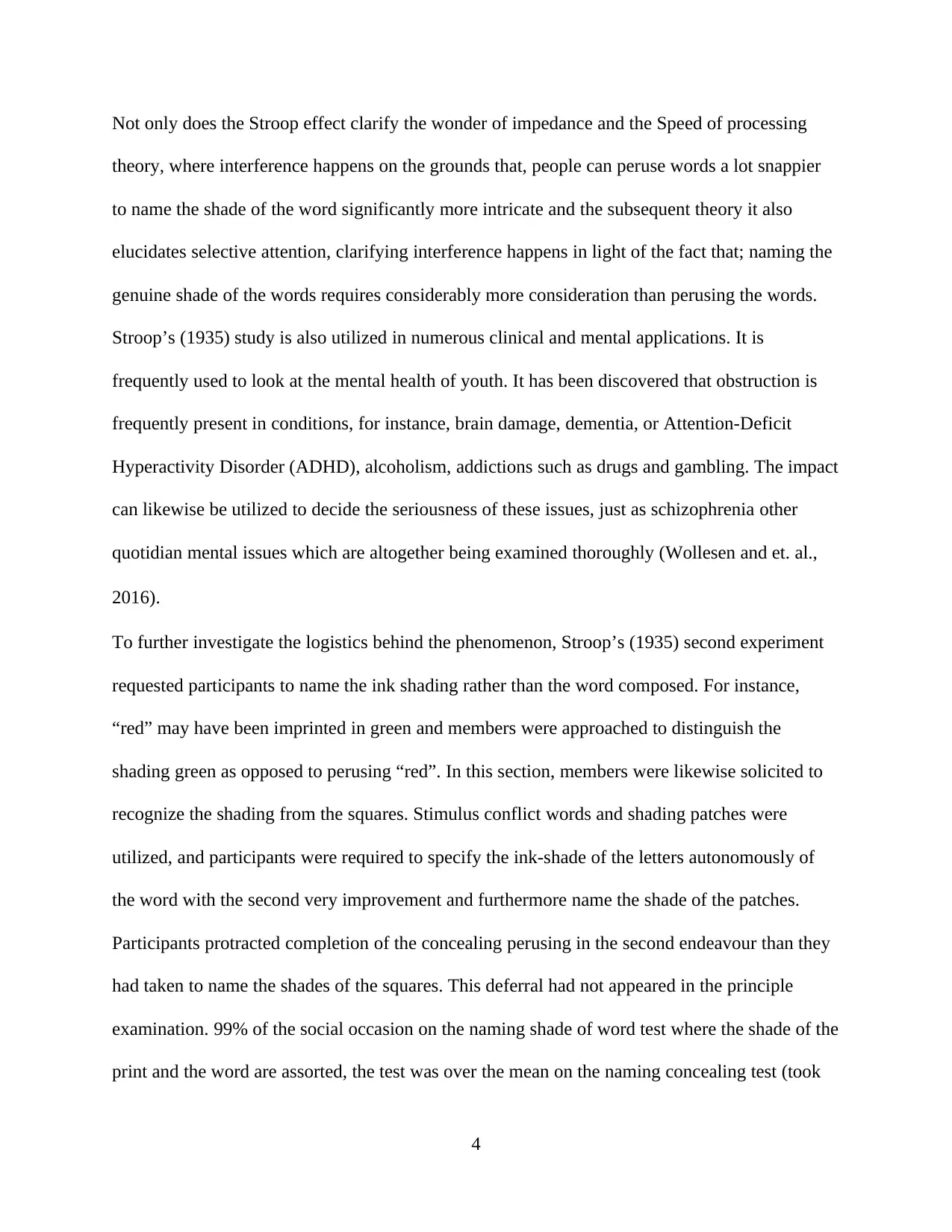
Not only does the Stroop effect clarify the wonder of impedance and the Speed of processing
theory, where interference happens on the grounds that, people can peruse words a lot snappier
to name the shade of the word significantly more intricate and the subsequent theory it also
elucidates selective attention, clarifying interference happens in light of the fact that; naming the
genuine shade of the words requires considerably more consideration than perusing the words.
Stroop’s (1935) study is also utilized in numerous clinical and mental applications. It is
frequently used to look at the mental health of youth. It has been discovered that obstruction is
frequently present in conditions, for instance, brain damage, dementia, or Attention-Deficit
Hyperactivity Disorder (ADHD), alcoholism, addictions such as drugs and gambling. The impact
can likewise be utilized to decide the seriousness of these issues, just as schizophrenia other
quotidian mental issues which are altogether being examined thoroughly (Wollesen and et. al.,
2016).
To further investigate the logistics behind the phenomenon, Stroop’s (1935) second experiment
requested participants to name the ink shading rather than the word composed. For instance,
“red” may have been imprinted in green and members were approached to distinguish the
shading green as opposed to perusing “red”. In this section, members were likewise solicited to
recognize the shading from the squares. Stimulus conflict words and shading patches were
utilized, and participants were required to specify the ink-shade of the letters autonomously of
the word with the second very improvement and furthermore name the shade of the patches.
Participants protracted completion of the concealing perusing in the second endeavour than they
had taken to name the shades of the squares. This deferral had not appeared in the principle
examination. 99% of the social occasion on the naming shade of word test where the shade of the
print and the word are assorted, the test was over the mean on the naming concealing test (took
4
theory, where interference happens on the grounds that, people can peruse words a lot snappier
to name the shade of the word significantly more intricate and the subsequent theory it also
elucidates selective attention, clarifying interference happens in light of the fact that; naming the
genuine shade of the words requires considerably more consideration than perusing the words.
Stroop’s (1935) study is also utilized in numerous clinical and mental applications. It is
frequently used to look at the mental health of youth. It has been discovered that obstruction is
frequently present in conditions, for instance, brain damage, dementia, or Attention-Deficit
Hyperactivity Disorder (ADHD), alcoholism, addictions such as drugs and gambling. The impact
can likewise be utilized to decide the seriousness of these issues, just as schizophrenia other
quotidian mental issues which are altogether being examined thoroughly (Wollesen and et. al.,
2016).
To further investigate the logistics behind the phenomenon, Stroop’s (1935) second experiment
requested participants to name the ink shading rather than the word composed. For instance,
“red” may have been imprinted in green and members were approached to distinguish the
shading green as opposed to perusing “red”. In this section, members were likewise solicited to
recognize the shading from the squares. Stimulus conflict words and shading patches were
utilized, and participants were required to specify the ink-shade of the letters autonomously of
the word with the second very improvement and furthermore name the shade of the patches.
Participants protracted completion of the concealing perusing in the second endeavour than they
had taken to name the shades of the squares. This deferral had not appeared in the principle
examination. 99% of the social occasion on the naming shade of word test where the shade of the
print and the word are assorted, the test was over the mean on the naming concealing test (took
4
Paraphrase This Document
Need a fresh take? Get an instant paraphrase of this document with our AI Paraphraser
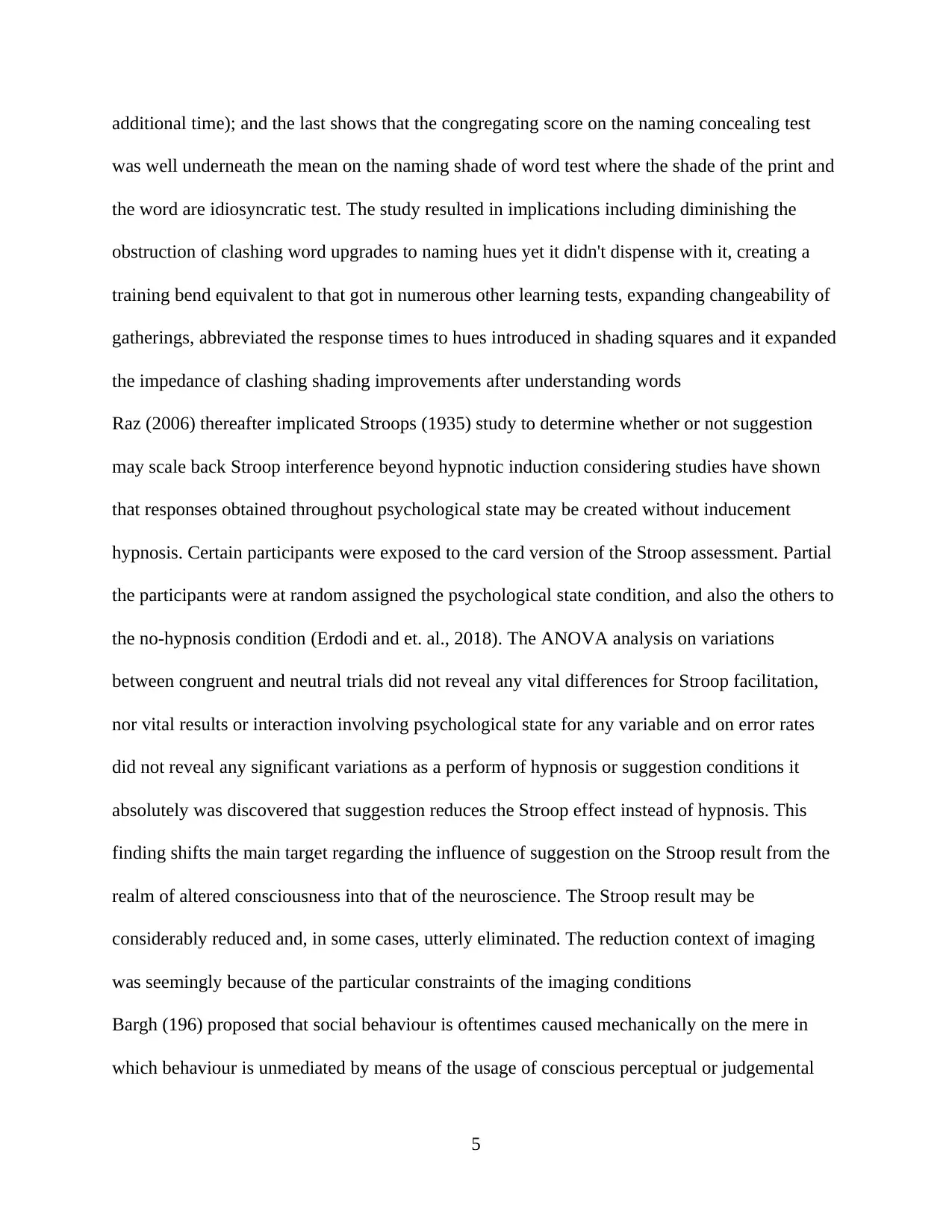
additional time); and the last shows that the congregating score on the naming concealing test
was well underneath the mean on the naming shade of word test where the shade of the print and
the word are idiosyncratic test. The study resulted in implications including diminishing the
obstruction of clashing word upgrades to naming hues yet it didn't dispense with it, creating a
training bend equivalent to that got in numerous other learning tests, expanding changeability of
gatherings, abbreviated the response times to hues introduced in shading squares and it expanded
the impedance of clashing shading improvements after understanding words
Raz (2006) thereafter implicated Stroops (1935) study to determine whether or not suggestion
may scale back Stroop interference beyond hypnotic induction considering studies have shown
that responses obtained throughout psychological state may be created without inducement
hypnosis. Certain participants were exposed to the card version of the Stroop assessment. Partial
the participants were at random assigned the psychological state condition, and also the others to
the no-hypnosis condition (Erdodi and et. al., 2018). The ANOVA analysis on variations
between congruent and neutral trials did not reveal any vital differences for Stroop facilitation,
nor vital results or interaction involving psychological state for any variable and on error rates
did not reveal any significant variations as a perform of hypnosis or suggestion conditions it
absolutely was discovered that suggestion reduces the Stroop effect instead of hypnosis. This
finding shifts the main target regarding the influence of suggestion on the Stroop result from the
realm of altered consciousness into that of the neuroscience. The Stroop result may be
considerably reduced and, in some cases, utterly eliminated. The reduction context of imaging
was seemingly because of the particular constraints of the imaging conditions
Bargh (196) proposed that social behaviour is oftentimes caused mechanically on the mere in
which behaviour is unmediated by means of the usage of conscious perceptual or judgemental
5
was well underneath the mean on the naming shade of word test where the shade of the print and
the word are idiosyncratic test. The study resulted in implications including diminishing the
obstruction of clashing word upgrades to naming hues yet it didn't dispense with it, creating a
training bend equivalent to that got in numerous other learning tests, expanding changeability of
gatherings, abbreviated the response times to hues introduced in shading squares and it expanded
the impedance of clashing shading improvements after understanding words
Raz (2006) thereafter implicated Stroops (1935) study to determine whether or not suggestion
may scale back Stroop interference beyond hypnotic induction considering studies have shown
that responses obtained throughout psychological state may be created without inducement
hypnosis. Certain participants were exposed to the card version of the Stroop assessment. Partial
the participants were at random assigned the psychological state condition, and also the others to
the no-hypnosis condition (Erdodi and et. al., 2018). The ANOVA analysis on variations
between congruent and neutral trials did not reveal any vital differences for Stroop facilitation,
nor vital results or interaction involving psychological state for any variable and on error rates
did not reveal any significant variations as a perform of hypnosis or suggestion conditions it
absolutely was discovered that suggestion reduces the Stroop effect instead of hypnosis. This
finding shifts the main target regarding the influence of suggestion on the Stroop result from the
realm of altered consciousness into that of the neuroscience. The Stroop result may be
considerably reduced and, in some cases, utterly eliminated. The reduction context of imaging
was seemingly because of the particular constraints of the imaging conditions
Bargh (196) proposed that social behaviour is oftentimes caused mechanically on the mere in
which behaviour is unmediated by means of the usage of conscious perceptual or judgemental
5
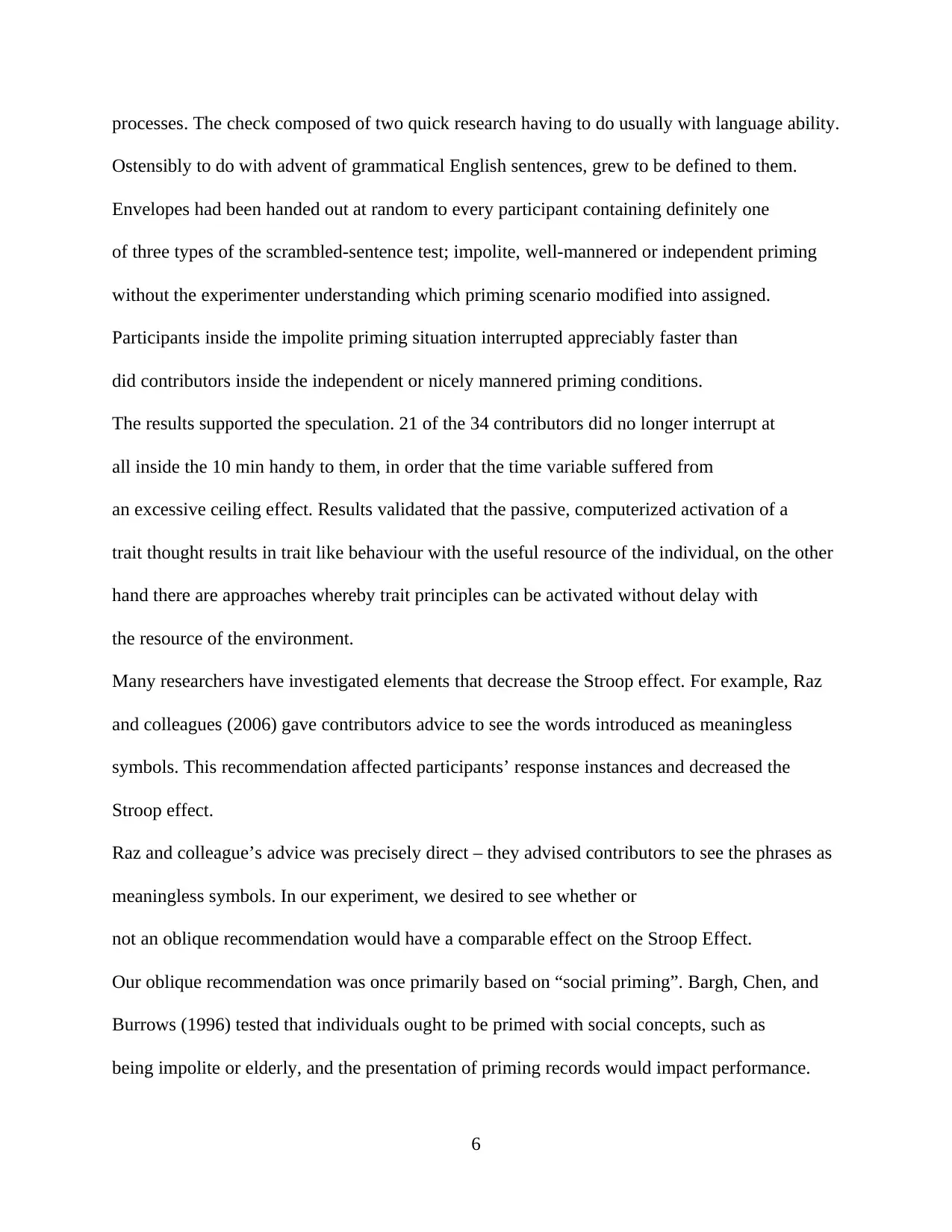
processes. The check composed of two quick research having to do usually with language ability.
Ostensibly to do with advent of grammatical English sentences, grew to be defined to them.
Envelopes had been handed out at random to every participant containing definitely one
of three types of the scrambled-sentence test; impolite, well-mannered or independent priming
without the experimenter understanding which priming scenario modified into assigned.
Participants inside the impolite priming situation interrupted appreciably faster than
did contributors inside the independent or nicely mannered priming conditions.
The results supported the speculation. 21 of the 34 contributors did no longer interrupt at
all inside the 10 min handy to them, in order that the time variable suffered from
an excessive ceiling effect. Results validated that the passive, computerized activation of a
trait thought results in trait like behaviour with the useful resource of the individual, on the other
hand there are approaches whereby trait principles can be activated without delay with
the resource of the environment.
Many researchers have investigated elements that decrease the Stroop effect. For example, Raz
and colleagues (2006) gave contributors advice to see the words introduced as meaningless
symbols. This recommendation affected participants’ response instances and decreased the
Stroop effect.
Raz and colleague’s advice was precisely direct – they advised contributors to see the phrases as
meaningless symbols. In our experiment, we desired to see whether or
not an oblique recommendation would have a comparable effect on the Stroop Effect.
Our oblique recommendation was once primarily based on “social priming”. Bargh, Chen, and
Burrows (1996) tested that individuals ought to be primed with social concepts, such as
being impolite or elderly, and the presentation of priming records would impact performance.
6
Ostensibly to do with advent of grammatical English sentences, grew to be defined to them.
Envelopes had been handed out at random to every participant containing definitely one
of three types of the scrambled-sentence test; impolite, well-mannered or independent priming
without the experimenter understanding which priming scenario modified into assigned.
Participants inside the impolite priming situation interrupted appreciably faster than
did contributors inside the independent or nicely mannered priming conditions.
The results supported the speculation. 21 of the 34 contributors did no longer interrupt at
all inside the 10 min handy to them, in order that the time variable suffered from
an excessive ceiling effect. Results validated that the passive, computerized activation of a
trait thought results in trait like behaviour with the useful resource of the individual, on the other
hand there are approaches whereby trait principles can be activated without delay with
the resource of the environment.
Many researchers have investigated elements that decrease the Stroop effect. For example, Raz
and colleagues (2006) gave contributors advice to see the words introduced as meaningless
symbols. This recommendation affected participants’ response instances and decreased the
Stroop effect.
Raz and colleague’s advice was precisely direct – they advised contributors to see the phrases as
meaningless symbols. In our experiment, we desired to see whether or
not an oblique recommendation would have a comparable effect on the Stroop Effect.
Our oblique recommendation was once primarily based on “social priming”. Bargh, Chen, and
Burrows (1996) tested that individuals ought to be primed with social concepts, such as
being impolite or elderly, and the presentation of priming records would impact performance.
6
⊘ This is a preview!⊘
Do you want full access?
Subscribe today to unlock all pages.

Trusted by 1+ million students worldwide
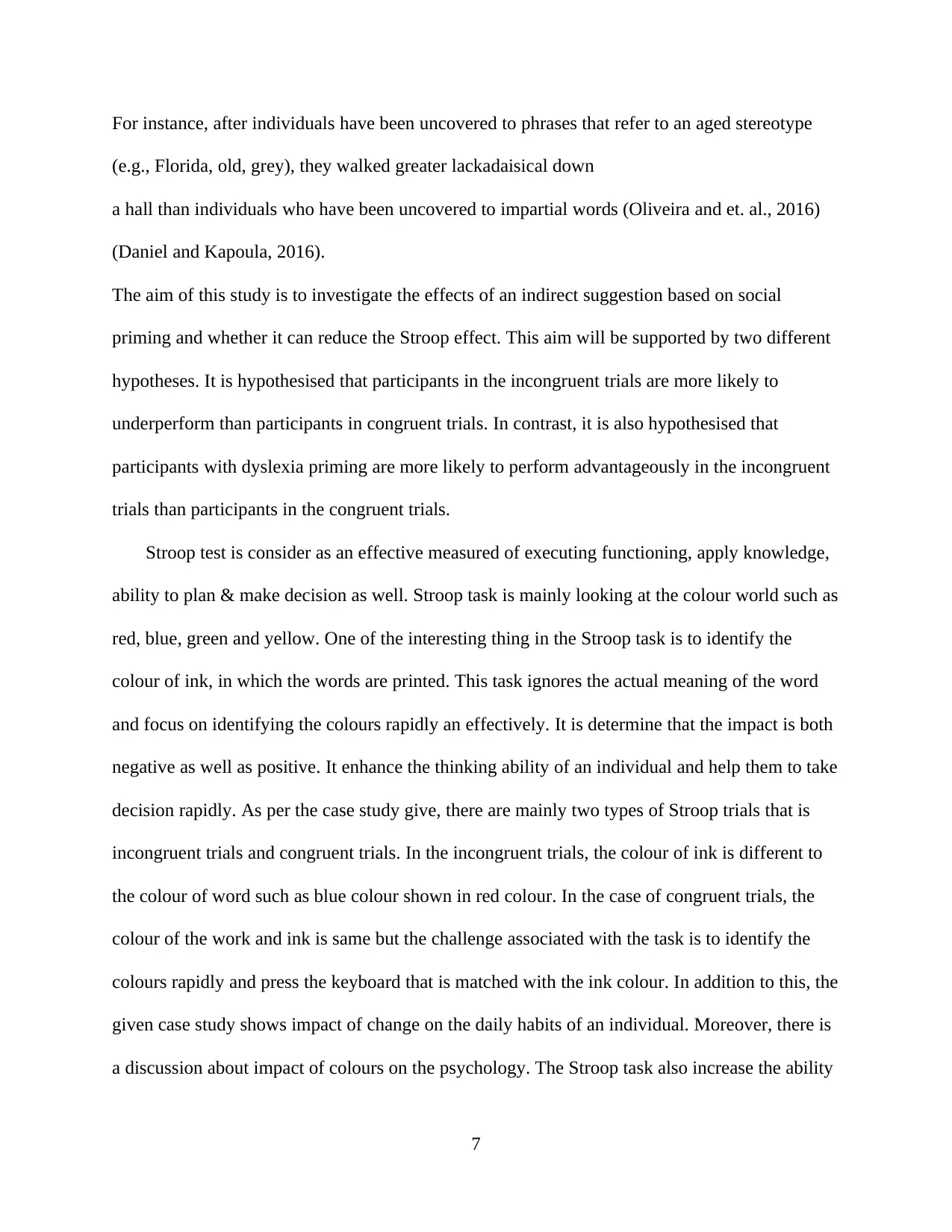
For instance, after individuals have been uncovered to phrases that refer to an aged stereotype
(e.g., Florida, old, grey), they walked greater lackadaisical down
a hall than individuals who have been uncovered to impartial words (Oliveira and et. al., 2016)
(Daniel and Kapoula, 2016).
The aim of this study is to investigate the effects of an indirect suggestion based on social
priming and whether it can reduce the Stroop effect. This aim will be supported by two different
hypotheses. It is hypothesised that participants in the incongruent trials are more likely to
underperform than participants in congruent trials. In contrast, it is also hypothesised that
participants with dyslexia priming are more likely to perform advantageously in the incongruent
trials than participants in the congruent trials.
Stroop test is consider as an effective measured of executing functioning, apply knowledge,
ability to plan & make decision as well. Stroop task is mainly looking at the colour world such as
red, blue, green and yellow. One of the interesting thing in the Stroop task is to identify the
colour of ink, in which the words are printed. This task ignores the actual meaning of the word
and focus on identifying the colours rapidly an effectively. It is determine that the impact is both
negative as well as positive. It enhance the thinking ability of an individual and help them to take
decision rapidly. As per the case study give, there are mainly two types of Stroop trials that is
incongruent trials and congruent trials. In the incongruent trials, the colour of ink is different to
the colour of word such as blue colour shown in red colour. In the case of congruent trials, the
colour of the work and ink is same but the challenge associated with the task is to identify the
colours rapidly and press the keyboard that is matched with the ink colour. In addition to this, the
given case study shows impact of change on the daily habits of an individual. Moreover, there is
a discussion about impact of colours on the psychology. The Stroop task also increase the ability
7
(e.g., Florida, old, grey), they walked greater lackadaisical down
a hall than individuals who have been uncovered to impartial words (Oliveira and et. al., 2016)
(Daniel and Kapoula, 2016).
The aim of this study is to investigate the effects of an indirect suggestion based on social
priming and whether it can reduce the Stroop effect. This aim will be supported by two different
hypotheses. It is hypothesised that participants in the incongruent trials are more likely to
underperform than participants in congruent trials. In contrast, it is also hypothesised that
participants with dyslexia priming are more likely to perform advantageously in the incongruent
trials than participants in the congruent trials.
Stroop test is consider as an effective measured of executing functioning, apply knowledge,
ability to plan & make decision as well. Stroop task is mainly looking at the colour world such as
red, blue, green and yellow. One of the interesting thing in the Stroop task is to identify the
colour of ink, in which the words are printed. This task ignores the actual meaning of the word
and focus on identifying the colours rapidly an effectively. It is determine that the impact is both
negative as well as positive. It enhance the thinking ability of an individual and help them to take
decision rapidly. As per the case study give, there are mainly two types of Stroop trials that is
incongruent trials and congruent trials. In the incongruent trials, the colour of ink is different to
the colour of word such as blue colour shown in red colour. In the case of congruent trials, the
colour of the work and ink is same but the challenge associated with the task is to identify the
colours rapidly and press the keyboard that is matched with the ink colour. In addition to this, the
given case study shows impact of change on the daily habits of an individual. Moreover, there is
a discussion about impact of colours on the psychology. The Stroop task also increase the ability
7
Paraphrase This Document
Need a fresh take? Get an instant paraphrase of this document with our AI Paraphraser
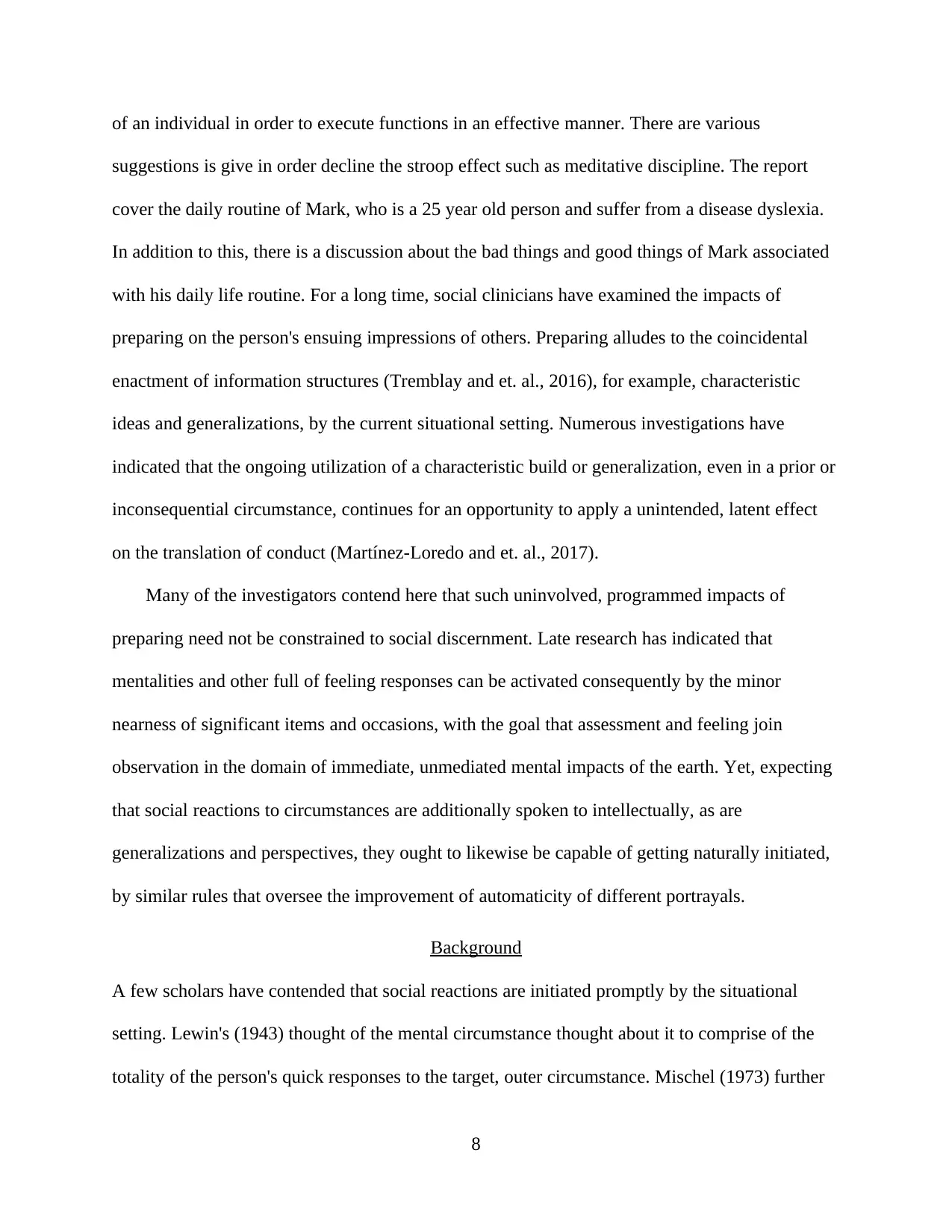
of an individual in order to execute functions in an effective manner. There are various
suggestions is give in order decline the stroop effect such as meditative discipline. The report
cover the daily routine of Mark, who is a 25 year old person and suffer from a disease dyslexia.
In addition to this, there is a discussion about the bad things and good things of Mark associated
with his daily life routine. For a long time, social clinicians have examined the impacts of
preparing on the person's ensuing impressions of others. Preparing alludes to the coincidental
enactment of information structures (Tremblay and et. al., 2016), for example, characteristic
ideas and generalizations, by the current situational setting. Numerous investigations have
indicated that the ongoing utilization of a characteristic build or generalization, even in a prior or
inconsequential circumstance, continues for an opportunity to apply a unintended, latent effect
on the translation of conduct (Martínez-Loredo and et. al., 2017).
Many of the investigators contend here that such uninvolved, programmed impacts of
preparing need not be constrained to social discernment. Late research has indicated that
mentalities and other full of feeling responses can be activated consequently by the minor
nearness of significant items and occasions, with the goal that assessment and feeling join
observation in the domain of immediate, unmediated mental impacts of the earth. Yet, expecting
that social reactions to circumstances are additionally spoken to intellectually, as are
generalizations and perspectives, they ought to likewise be capable of getting naturally initiated,
by similar rules that oversee the improvement of automaticity of different portrayals.
Background
A few scholars have contended that social reactions are initiated promptly by the situational
setting. Lewin's (1943) thought of the mental circumstance thought about it to comprise of the
totality of the person's quick responses to the target, outer circumstance. Mischel (1973) further
8
suggestions is give in order decline the stroop effect such as meditative discipline. The report
cover the daily routine of Mark, who is a 25 year old person and suffer from a disease dyslexia.
In addition to this, there is a discussion about the bad things and good things of Mark associated
with his daily life routine. For a long time, social clinicians have examined the impacts of
preparing on the person's ensuing impressions of others. Preparing alludes to the coincidental
enactment of information structures (Tremblay and et. al., 2016), for example, characteristic
ideas and generalizations, by the current situational setting. Numerous investigations have
indicated that the ongoing utilization of a characteristic build or generalization, even in a prior or
inconsequential circumstance, continues for an opportunity to apply a unintended, latent effect
on the translation of conduct (Martínez-Loredo and et. al., 2017).
Many of the investigators contend here that such uninvolved, programmed impacts of
preparing need not be constrained to social discernment. Late research has indicated that
mentalities and other full of feeling responses can be activated consequently by the minor
nearness of significant items and occasions, with the goal that assessment and feeling join
observation in the domain of immediate, unmediated mental impacts of the earth. Yet, expecting
that social reactions to circumstances are additionally spoken to intellectually, as are
generalizations and perspectives, they ought to likewise be capable of getting naturally initiated,
by similar rules that oversee the improvement of automaticity of different portrayals.
Background
A few scholars have contended that social reactions are initiated promptly by the situational
setting. Lewin's (1943) thought of the mental circumstance thought about it to comprise of the
totality of the person's quick responses to the target, outer circumstance. Mischel (1973) further
8
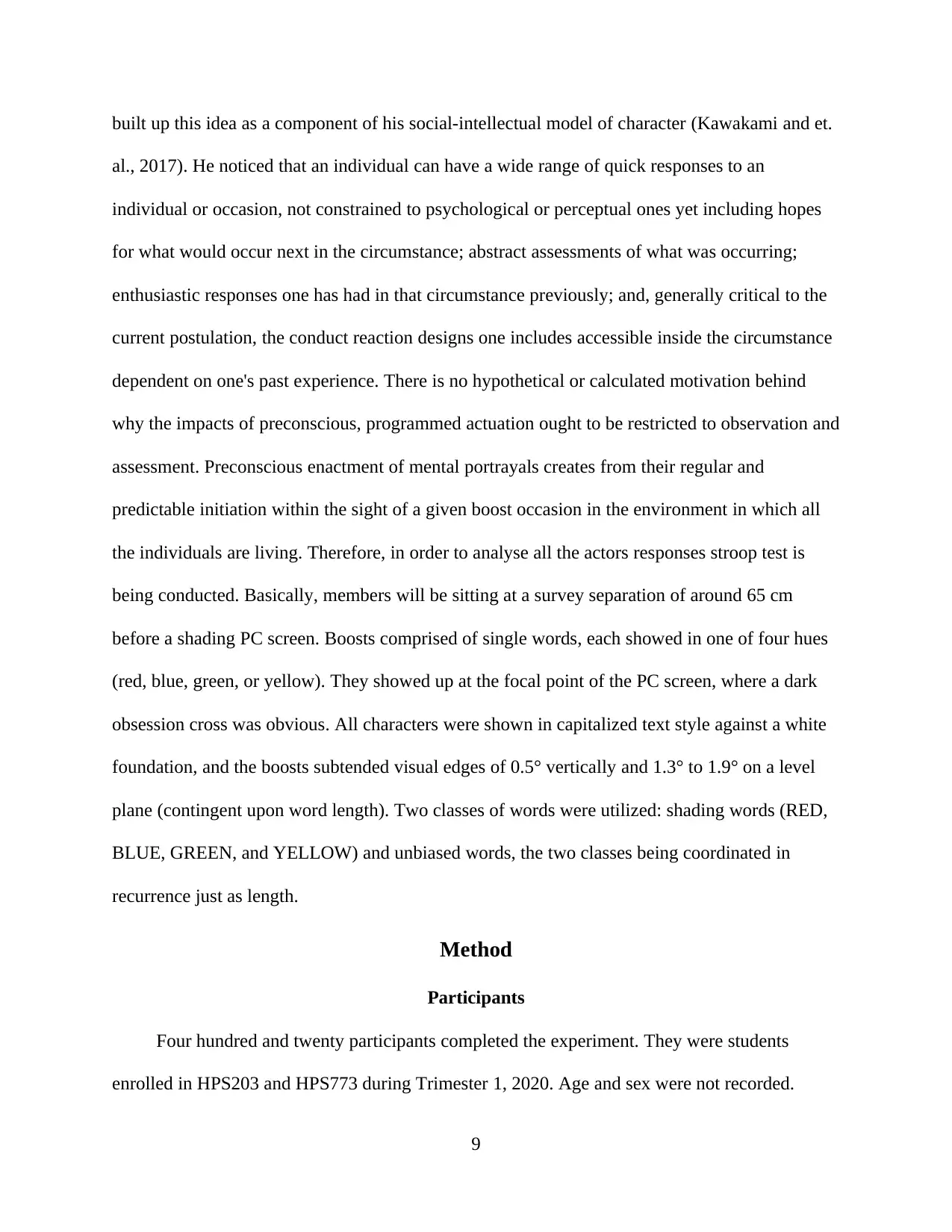
built up this idea as a component of his social-intellectual model of character (Kawakami and et.
al., 2017). He noticed that an individual can have a wide range of quick responses to an
individual or occasion, not constrained to psychological or perceptual ones yet including hopes
for what would occur next in the circumstance; abstract assessments of what was occurring;
enthusiastic responses one has had in that circumstance previously; and, generally critical to the
current postulation, the conduct reaction designs one includes accessible inside the circumstance
dependent on one's past experience. There is no hypothetical or calculated motivation behind
why the impacts of preconscious, programmed actuation ought to be restricted to observation and
assessment. Preconscious enactment of mental portrayals creates from their regular and
predictable initiation within the sight of a given boost occasion in the environment in which all
the individuals are living. Therefore, in order to analyse all the actors responses stroop test is
being conducted. Basically, members will be sitting at a survey separation of around 65 cm
before a shading PC screen. Boosts comprised of single words, each showed in one of four hues
(red, blue, green, or yellow). They showed up at the focal point of the PC screen, where a dark
obsession cross was obvious. All characters were shown in capitalized text style against a white
foundation, and the boosts subtended visual edges of 0.5° vertically and 1.3° to 1.9° on a level
plane (contingent upon word length). Two classes of words were utilized: shading words (RED,
BLUE, GREEN, and YELLOW) and unbiased words, the two classes being coordinated in
recurrence just as length.
Method
Participants
Four hundred and twenty participants completed the experiment. They were students
enrolled in HPS203 and HPS773 during Trimester 1, 2020. Age and sex were not recorded.
9
al., 2017). He noticed that an individual can have a wide range of quick responses to an
individual or occasion, not constrained to psychological or perceptual ones yet including hopes
for what would occur next in the circumstance; abstract assessments of what was occurring;
enthusiastic responses one has had in that circumstance previously; and, generally critical to the
current postulation, the conduct reaction designs one includes accessible inside the circumstance
dependent on one's past experience. There is no hypothetical or calculated motivation behind
why the impacts of preconscious, programmed actuation ought to be restricted to observation and
assessment. Preconscious enactment of mental portrayals creates from their regular and
predictable initiation within the sight of a given boost occasion in the environment in which all
the individuals are living. Therefore, in order to analyse all the actors responses stroop test is
being conducted. Basically, members will be sitting at a survey separation of around 65 cm
before a shading PC screen. Boosts comprised of single words, each showed in one of four hues
(red, blue, green, or yellow). They showed up at the focal point of the PC screen, where a dark
obsession cross was obvious. All characters were shown in capitalized text style against a white
foundation, and the boosts subtended visual edges of 0.5° vertically and 1.3° to 1.9° on a level
plane (contingent upon word length). Two classes of words were utilized: shading words (RED,
BLUE, GREEN, and YELLOW) and unbiased words, the two classes being coordinated in
recurrence just as length.
Method
Participants
Four hundred and twenty participants completed the experiment. They were students
enrolled in HPS203 and HPS773 during Trimester 1, 2020. Age and sex were not recorded.
9
⊘ This is a preview!⊘
Do you want full access?
Subscribe today to unlock all pages.

Trusted by 1+ million students worldwide
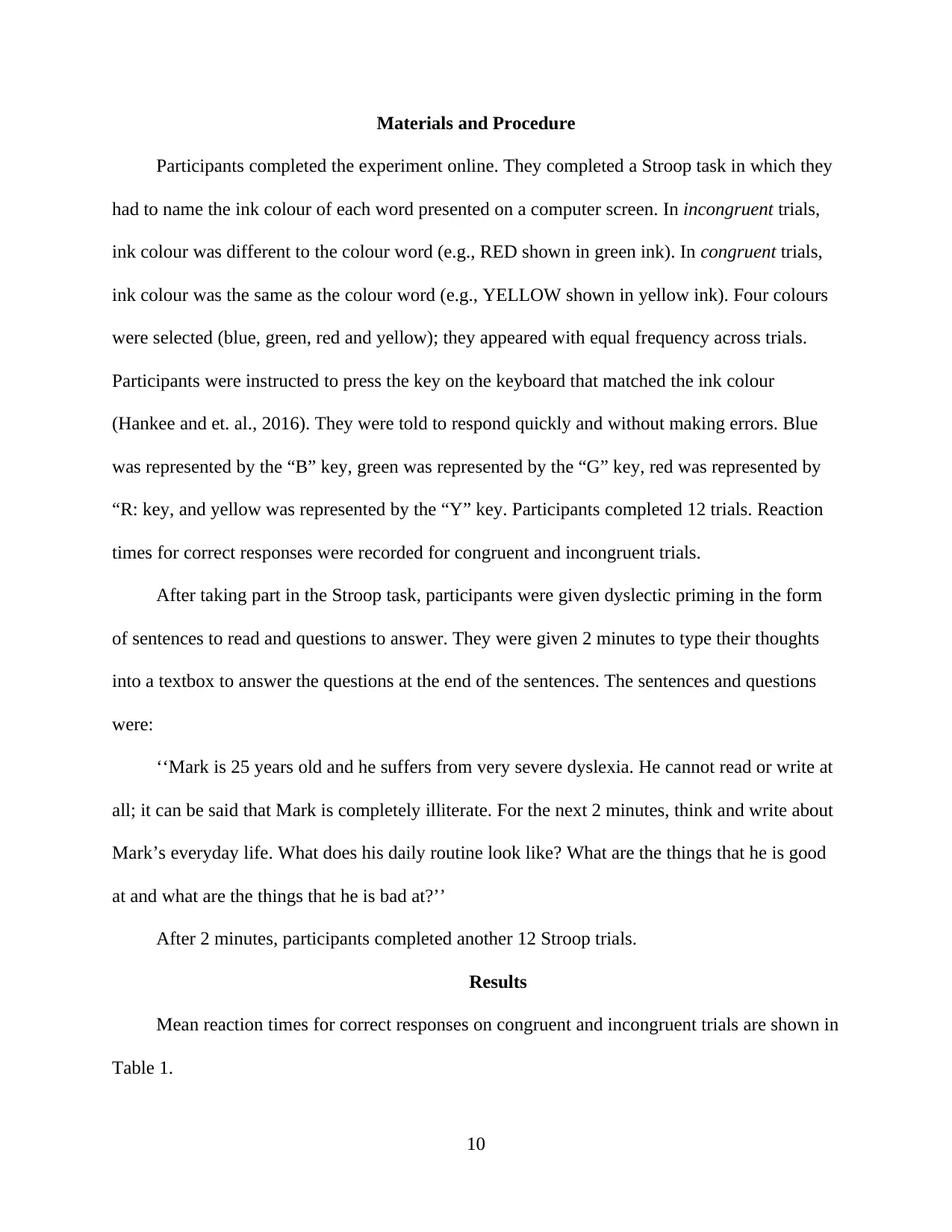
Materials and Procedure
Participants completed the experiment online. They completed a Stroop task in which they
had to name the ink colour of each word presented on a computer screen. In incongruent trials,
ink colour was different to the colour word (e.g., RED shown in green ink). In congruent trials,
ink colour was the same as the colour word (e.g., YELLOW shown in yellow ink). Four colours
were selected (blue, green, red and yellow); they appeared with equal frequency across trials.
Participants were instructed to press the key on the keyboard that matched the ink colour
(Hankee and et. al., 2016). They were told to respond quickly and without making errors. Blue
was represented by the “B” key, green was represented by the “G” key, red was represented by
“R: key, and yellow was represented by the “Y” key. Participants completed 12 trials. Reaction
times for correct responses were recorded for congruent and incongruent trials.
After taking part in the Stroop task, participants were given dyslectic priming in the form
of sentences to read and questions to answer. They were given 2 minutes to type their thoughts
into a textbox to answer the questions at the end of the sentences. The sentences and questions
were:
‘‘Mark is 25 years old and he suffers from very severe dyslexia. He cannot read or write at
all; it can be said that Mark is completely illiterate. For the next 2 minutes, think and write about
Mark’s everyday life. What does his daily routine look like? What are the things that he is good
at and what are the things that he is bad at?’’
After 2 minutes, participants completed another 12 Stroop trials.
Results
Mean reaction times for correct responses on congruent and incongruent trials are shown in
Table 1.
10
Participants completed the experiment online. They completed a Stroop task in which they
had to name the ink colour of each word presented on a computer screen. In incongruent trials,
ink colour was different to the colour word (e.g., RED shown in green ink). In congruent trials,
ink colour was the same as the colour word (e.g., YELLOW shown in yellow ink). Four colours
were selected (blue, green, red and yellow); they appeared with equal frequency across trials.
Participants were instructed to press the key on the keyboard that matched the ink colour
(Hankee and et. al., 2016). They were told to respond quickly and without making errors. Blue
was represented by the “B” key, green was represented by the “G” key, red was represented by
“R: key, and yellow was represented by the “Y” key. Participants completed 12 trials. Reaction
times for correct responses were recorded for congruent and incongruent trials.
After taking part in the Stroop task, participants were given dyslectic priming in the form
of sentences to read and questions to answer. They were given 2 minutes to type their thoughts
into a textbox to answer the questions at the end of the sentences. The sentences and questions
were:
‘‘Mark is 25 years old and he suffers from very severe dyslexia. He cannot read or write at
all; it can be said that Mark is completely illiterate. For the next 2 minutes, think and write about
Mark’s everyday life. What does his daily routine look like? What are the things that he is good
at and what are the things that he is bad at?’’
After 2 minutes, participants completed another 12 Stroop trials.
Results
Mean reaction times for correct responses on congruent and incongruent trials are shown in
Table 1.
10
Paraphrase This Document
Need a fresh take? Get an instant paraphrase of this document with our AI Paraphraser

Table 1. Mean reaction times for correct trials (ms)
Congruent trials Incongruent trials
Before dyslectic priming 702 (21) 759 (22)
After dyslectic priming 705 (20) 710 (21)
Note. Figures in parentheses are standard deviations
Two paired t-tests were conducted to determine whether there was a significant difference
between reaction times for congruent vs incongruent trials before the dyslectic priming and after
the dyslectic priming. Before priming, there was a significant difference in reaction time between
the congruent and incongruent trials, t(419) = 5.41, p = .001. After priming, there was no
significant difference in reaction time between the congruent and incongruent trials, t(419) =
1.21, p = .24.
Discussion
The point of this examination is to research the impacts of an aberrant proposal dependent
on social preparing and whether it can diminish the Stroop impact. This point will be bolstered
by two unique theories. It is conjectured that members in the incongruent preliminaries are
bound to fail to meet expectations than members in consistent preliminaries (González-Giraldo
and et. al., 2016). Conversely, it is likewise guessed that members with dyslexia preparing are
bound to perform favourably in the incongruent preliminaries than members in the compatible
preliminaries. Therefore, considering all the results that has been carried out it can easily be said
that most of the Two matched t-tests were led to decide if there was a huge distinction between
response times for congruent versus incongruent preliminaries before the dyslectic preparing and
after the dyslectic preparing. Prior to preparing, there was a noteworthy distinction in response
11
Congruent trials Incongruent trials
Before dyslectic priming 702 (21) 759 (22)
After dyslectic priming 705 (20) 710 (21)
Note. Figures in parentheses are standard deviations
Two paired t-tests were conducted to determine whether there was a significant difference
between reaction times for congruent vs incongruent trials before the dyslectic priming and after
the dyslectic priming. Before priming, there was a significant difference in reaction time between
the congruent and incongruent trials, t(419) = 5.41, p = .001. After priming, there was no
significant difference in reaction time between the congruent and incongruent trials, t(419) =
1.21, p = .24.
Discussion
The point of this examination is to research the impacts of an aberrant proposal dependent
on social preparing and whether it can diminish the Stroop impact. This point will be bolstered
by two unique theories. It is conjectured that members in the incongruent preliminaries are
bound to fail to meet expectations than members in consistent preliminaries (González-Giraldo
and et. al., 2016). Conversely, it is likewise guessed that members with dyslexia preparing are
bound to perform favourably in the incongruent preliminaries than members in the compatible
preliminaries. Therefore, considering all the results that has been carried out it can easily be said
that most of the Two matched t-tests were led to decide if there was a huge distinction between
response times for congruent versus incongruent preliminaries before the dyslectic preparing and
after the dyslectic preparing. Prior to preparing, there was a noteworthy distinction in response
11
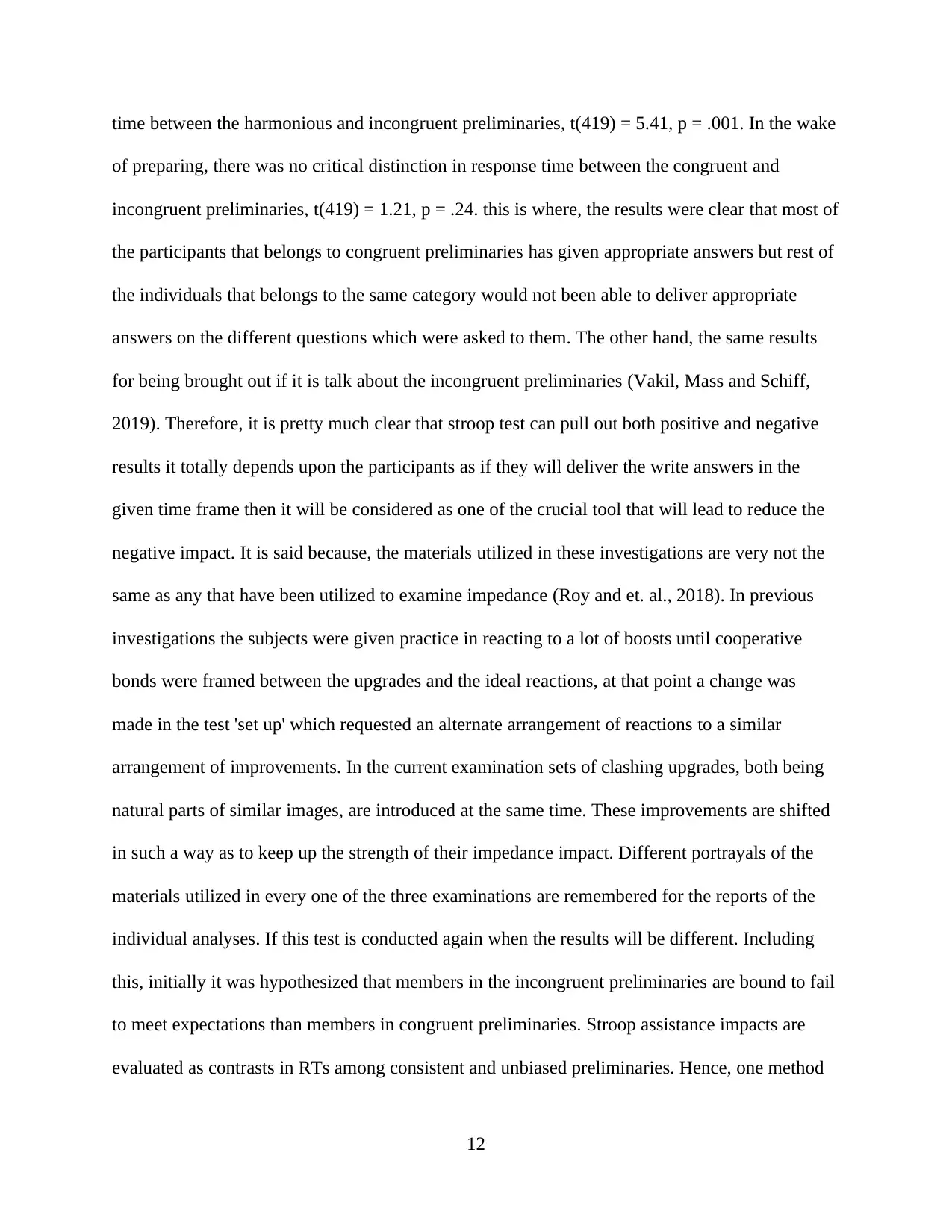
time between the harmonious and incongruent preliminaries, t(419) = 5.41, p = .001. In the wake
of preparing, there was no critical distinction in response time between the congruent and
incongruent preliminaries, t(419) = 1.21, p = .24. this is where, the results were clear that most of
the participants that belongs to congruent preliminaries has given appropriate answers but rest of
the individuals that belongs to the same category would not been able to deliver appropriate
answers on the different questions which were asked to them. The other hand, the same results
for being brought out if it is talk about the incongruent preliminaries (Vakil, Mass and Schiff,
2019). Therefore, it is pretty much clear that stroop test can pull out both positive and negative
results it totally depends upon the participants as if they will deliver the write answers in the
given time frame then it will be considered as one of the crucial tool that will lead to reduce the
negative impact. It is said because, the materials utilized in these investigations are very not the
same as any that have been utilized to examine impedance (Roy and et. al., 2018). In previous
investigations the subjects were given practice in reacting to a lot of boosts until cooperative
bonds were framed between the upgrades and the ideal reactions, at that point a change was
made in the test 'set up' which requested an alternate arrangement of reactions to a similar
arrangement of improvements. In the current examination sets of clashing upgrades, both being
natural parts of similar images, are introduced at the same time. These improvements are shifted
in such a way as to keep up the strength of their impedance impact. Different portrayals of the
materials utilized in every one of the three examinations are remembered for the reports of the
individual analyses. If this test is conducted again when the results will be different. Including
this, initially it was hypothesized that members in the incongruent preliminaries are bound to fail
to meet expectations than members in congruent preliminaries. Stroop assistance impacts are
evaluated as contrasts in RTs among consistent and unbiased preliminaries. Hence, one method
12
of preparing, there was no critical distinction in response time between the congruent and
incongruent preliminaries, t(419) = 1.21, p = .24. this is where, the results were clear that most of
the participants that belongs to congruent preliminaries has given appropriate answers but rest of
the individuals that belongs to the same category would not been able to deliver appropriate
answers on the different questions which were asked to them. The other hand, the same results
for being brought out if it is talk about the incongruent preliminaries (Vakil, Mass and Schiff,
2019). Therefore, it is pretty much clear that stroop test can pull out both positive and negative
results it totally depends upon the participants as if they will deliver the write answers in the
given time frame then it will be considered as one of the crucial tool that will lead to reduce the
negative impact. It is said because, the materials utilized in these investigations are very not the
same as any that have been utilized to examine impedance (Roy and et. al., 2018). In previous
investigations the subjects were given practice in reacting to a lot of boosts until cooperative
bonds were framed between the upgrades and the ideal reactions, at that point a change was
made in the test 'set up' which requested an alternate arrangement of reactions to a similar
arrangement of improvements. In the current examination sets of clashing upgrades, both being
natural parts of similar images, are introduced at the same time. These improvements are shifted
in such a way as to keep up the strength of their impedance impact. Different portrayals of the
materials utilized in every one of the three examinations are remembered for the reports of the
individual analyses. If this test is conducted again when the results will be different. Including
this, initially it was hypothesized that members in the incongruent preliminaries are bound to fail
to meet expectations than members in congruent preliminaries. Stroop assistance impacts are
evaluated as contrasts in RTs among consistent and unbiased preliminaries. Hence, one method
12
⊘ This is a preview!⊘
Do you want full access?
Subscribe today to unlock all pages.

Trusted by 1+ million students worldwide
1 out of 17
Your All-in-One AI-Powered Toolkit for Academic Success.
+13062052269
info@desklib.com
Available 24*7 on WhatsApp / Email
![[object Object]](/_next/static/media/star-bottom.7253800d.svg)
Unlock your academic potential
Copyright © 2020–2025 A2Z Services. All Rights Reserved. Developed and managed by ZUCOL.